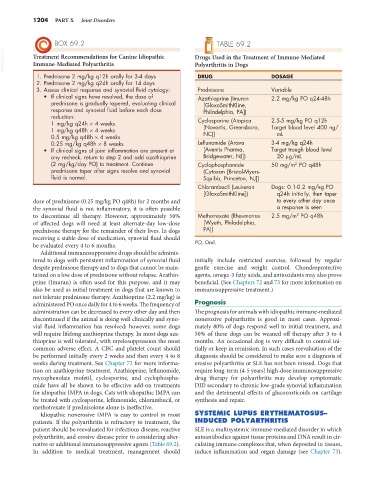Page 1232 - Small Animal Internal Medicine, 6th Edition
P. 1232
1204 PART X Joint Disorders
BOX 69.2 TABLE 69.2
VetBooks.ir Treatment Recommendations for Canine Idiopathic Drugs Used in the Treatment of Immune-Mediated
Immune-Mediated Polyarthritis
Polyarthritis in Dogs
1. Prednisone 2 mg/kg q12h orally for 3-4 days DRUG DOSAGE
2. Prednisone 2 mg/kg q24h orally for 14 days
3. Assess clinical response and synovial fluid cytology: Prednisone Variable
• If clinical signs have resolved, the dose of Azathioprine (Imuran 2.2 mg/kg PO q24-48h
prednisone is gradually tapered, evaluating clinical [GlaxoSmithKline,
response and synovial fluid before each dose Philadelphia, PA])
reduction:
1 mg/kg q24h × 4 weeks Cyclosporine (Atopica 2.5-5 mg/kg PO q12h
1 mg/kg q48h × 4 weeks [Novartis, Greensboro, Target blood level 400 ng/
0.5 mg/kg q48h × 4 weeks NC]) mL
0.25 mg/kg q48h × 8 weeks Leflunomide (Arava 3-4 mg/kg q24h
• If clinical signs of joint inflammation are present at [Aventis Pharma, Target trough blood level
any recheck, return to step 2 and add azathioprine Bridgewater, NJ]) 20 µg/mL
(2 mg/kg/day PO) to treatment. Continue Cyclophosphamide 50 mg/m PO q48h
2
prednisone taper after signs resolve and synovial (Cytoxan [Bristol-Myers-
fluid is normal. Squibb, Princeton, NJ])
Chlorambucil (Leukeran Dogs: 0.1-0.2 mg/kg PO
[GlaxoSmithKline]) q24h initially, then taper
dose of prednisone (0.25 mg/kg PO q48h) for 2 months and to every other day once
the synovial fluid is not inflammatory, it is often possible a response is seen
2
to discontinue all therapy. However, approximately 50% Methotrexate (Rheumatrex 2.5 mg/m PO q48h
of affected dogs will need at least alternate-day low-dose [Wyeth, Philadelphia,
prednisone therapy for the remainder of their lives. In dogs PA])
receiving a stable dose of medication, synovial fluid should
be evaluated every 4 to 6 months. PO, Oral.
Additional immunosuppressive drugs should be adminis-
tered to dogs with persistent inflammation of synovial fluid initially include restricted exercise, followed by regular
despite prednisone therapy and to dogs that cannot be main- gentle exercise and weight control. Chondroprotective
tained on a low dose of prednisone without relapse. Azathio- agents, omega-3 fatty acids, and antioxidants may also prove
prine (Imuran) is often used for this purpose, and it may beneficial. (See Chapters 72 and 73 for more information on
also be used as initial treatment in dogs that are known to immunosuppressive treatment.)
not tolerate prednisone therapy. Azathioprine (2.2 mg/kg) is
administered PO once daily for 4 to 6 weeks. The frequency of Prognosis
administration can be decreased to every other day and then The prognosis for animals with idiopathic immune-mediated
discontinued if the animal is doing well clinically and syno- nonerosive polyarthritis is good in most cases. Approxi-
vial fluid inflammation has resolved; however, some dogs mately 80% of dogs respond well to initial treatment, and
will require lifelong azathioprine therapy. In most dogs aza- 50% of these dogs can be weaned off therapy after 3 to 4
thioprine is well tolerated, with myelosuppression the most months. An occasional dog is very difficult to control ini-
common adverse effect. A CBC and platelet count should tially or keep in remission. In such cases reevaluation of the
be performed initially every 2 weeks and then every 4 to 8 diagnosis should be considered to make sure a diagnosis of
weeks during treatment. See Chapter 72 for more informa- erosive polyarthritis or SLE has not been missed. Dogs that
tion on azathioprine treatment. Azathioprine, leflunomide, require long-term (4-5 years) high-dose immunosuppressive
mycophenolate mofetil, cyclosporine, and cyclophospha- drug therapy for polyarthritis may develop symptomatic
mide have all be shown to be effective add-on treatments DJD secondary to chronic low-grade synovial inflammation
for idiopathic IMPA in dogs. Cats with idiopathic IMPA can and the detrimental effects of glucocorticoids on cartilage
be treated with cyclosporine, leflunomide, chlorambucil, or synthesis and repair.
methotrexate if prednisolone alone is ineffective.
Idiopathic nonerosive IMPA is easy to control in most SYSTEMIC LUPUS ERYTHEMATOSUS–
patients. If the polyarthritis is refractory to treatment, the INDUCED POLYARTHRITIS
patient should be reevaluated for infectious disease, reactive SLE is a multisystemic immune-mediated disorder in which
polyarthritis, and erosive disease prior to considering alter- autoantibodies against tissue proteins and DNA result in cir-
native or additional immunosuppressive agents (Table 69.2). culating immune complexes that, when deposited in tissues,
In addition to medical treatment, management should induce inflammation and organ damage (see Chapter 73).

